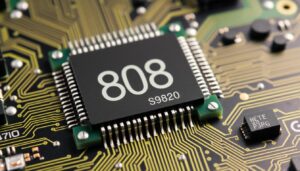The 8086 microprocessor is a powerful chip used in computers for processing data. To understand how it works, we need to learn about its pin diagram, which shows all the connections and functions of the microprocessor.
Each pin has a specific role, like sending or receiving data, controlling operations, or providing power.
This article will help you understand the pin diagram of 8086 in simple terms, breaking down the main components and their functions.
Read more:Understanding Fragmentation in OS
8086 Microprocessor
The 8086 is an essential microprocessor used in computers to perform various tasks. It’s like the brain of the computer, helping it run programs and process information.
- Manages and controls the data flow in the computer.
- Works with various computer systems and devices.

Pin Diagram
The pin diagram is like a map of the 8086 microprocessor, showing how it connects to other parts of the computer.
- AD0-AD15 (Pins 2-16)
These 16 multiplexed pins serve dual purposes, acting as both data and address lines. During different phases of operation, they carry either data or address information.
- A16-A19/S3-S6 (Pins 35-38)
These four pins are multiplexed between higher address bits (A16-A19) and status signals (S3-S6). They handle extended addressing or indicate the status of the microprocessor. - BHE/S7 (Pin 34)
This pin functions as the Bus High Enable (BHE) signal, controlling access to the higher byte of the data bus, or as Status 7 (S7) in certain modes. - RD (Pin 32)
The Read (RD) pin is used to signal memory or an I/O device to place data on the data bus, allowing the microprocessor to read it. - WR (Pin 29)
The Write (WR) pin signals that the microprocessor is writing data to a memory location or I/O device. - M/IO (Pin 28)
The Memory/Input-Output (M/IO) pin indicates whether the current operation is accessing memory (M) or an I/O device (IO). - DT/R (Pin 27)
The Data Transmit/Receive (DT/R) pin controls the direction of data flow on the data bus, determining whether data is being sent or received. - DEN (Pin 26)
The Data Enable (DEN) pin enables the transceivers during data transfers, ensuring that data is properly communicated on the bus.
- ALE (Pin 25)
The Address Latch Enable (ALE) pin signals when the address is valid on the address/data bus, allowing it to be latched for processing. - INTA (Pin 24)
The Interrupt Acknowledge (INTA) pin is used by the microprocessor to acknowledge the receipt of an interrupt request, preparing to handle the interrupt. - HLDA (Pin 30)
The Hold Acknowledge (HLDA) pin signals that the microprocessor has acknowledged a hold request and is granting bus control to another device. - HOLD (Pin 31)
The HOLD pin requests control of the system bus from the microprocessor, typically for Direct Memory Access (DMA) operations. - NMI (Pin 17)
The Non-Maskable Interrupt (NMI) pin triggers a high-priority interrupt that cannot be ignored by the microprocessor, ensuring immediate attention. - INTR (Pin 18)
The Interrupt Request (INTR) pin is used to signal a general interrupt to the microprocessor, which can be handled based on its priority. - CLK (Pin 19)
The Clock (CLK) pin provides the necessary timing for the microprocessor’s operations, ensuring synchronized execution of instructions. - RESET (Pin 21)
The Reset (RESET) pin resets the microprocessor, clearing all registers and initiating the start-up sequence. - READY (Pin 22)
The Ready (READY) pin indicates that a peripheral device is prepared for data transfer, allowing the microprocessor to proceed with operations. - TEST (Pin 23)
The Test (TEST) pin is used during diagnostic or testing operations, typically controlling wait states when checked by the WAIT instruction. - MN/MX (Pin 33)
The Minimum/Maximum (MN/MX) pin selects the operating mode of the microprocessor, determining whether it operates in minimum or maximum mode. - VCC (Pin 40)
The VCC pin supplies power to the microprocessor, providing the necessary voltage for its operation. - GND (Pins 1 & 20)
The Ground (GND) pins connect the microprocessor to the ground, completing the electrical circuit and ensuring proper operation. 
Conclusion
Each of the 40 pins on the 8086 microprocessor has a specific and vital role in its operation, whether it’s managing data flow, controlling power, or handling specific functions. Understanding these pins is key to grasping how the 8086 microprocessor operates within a computer system.











